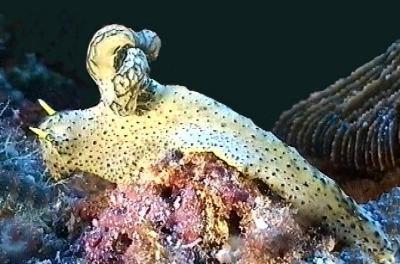
Notodoris serenae
Gosliner & Behrens, 1997
Order: NUDIBRANCHIA
Suborder: DORIDINA
Superfamily: ANADORIDOIDEA
Family: Aegiretidae
DISTRIBUTION
Tropical Western Pacific [Papua New Guinea, Indonesia, Malaysia, Philippines, Palau, Pohnpei and Okinawa (Gosliner & Behrens, 1997). reported in Forum also from Solomon Ids]
PHOTO
Russell Islands, Solomon Ids. Approx 12 meters. September, 2000. Photo: Bruce Potter.
Differs from other known species of Notodoris in its colour pattern, ranging in colour from dull white to grey-green with scattered raised black spots. The most characteristic difference is the development of 3 long extrabranchial appendages which shield the three distinct gills. It can grow to more than 10cm and feeds on the calcareous sponge Leucetta chagosensis Dendy, 1913.
Reference:
• Gosliner, T.M. & Behrens, D.W. (1997) Description of four new species of Phanerobranch dorids from the Indo-Pacific, with a redescription of Gymnodoris aurita (Gould, 1852). Proceedings of the California Academy of Sciences, 49(9): 287-308.
Rudman, W.B., 2000 (October 25) Notodoris serenae Gosliner & Behrens, 1997. [In] Sea Slug Forum. Australian Museum, Sydney. Available from http://www.seaslugforum.net/find/notosere
Related messages
Notodoris serenae from Philippines
July 21, 2008
From: Gaetan White
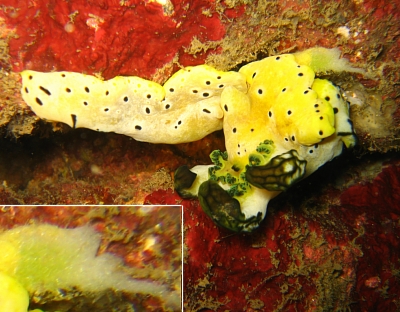
Concerning message #19974:
Dear Bill
I found these two Notodoris serenae and a dozen others, whilst re-exploring around the Romblon islands, (Tablas, Romblon, Sibuyan), Philippines, (one of my favorite nudy, squid and sea-horse observation spots in Asia), during April 2008.
On Sibuyan island, the dramatic increase of heavy maritime traffic with its nimby bilging, deforestation in the north, cyanide/naphthalene fishing mainly by Mindanao refugees, (giant squid hunting specialists, but not many of them left either!), agricultural products on mango (the whole production is ripe the same week!), coconut, rice etc plantations, 2005-7 mercury/acid use in illegal gold rush mines in the north east, opening of manganese-nickel (gold) mine by Australo-Can-Phil. remake of 'Marinduque tailings' operators on the east, foreigners building X20 cost price houses for 2 months yearly use with no water (abandoned after 2nd year!) on unlivable coastlines, are taking their toll. In the last 24 months, corals and sponges have decreased by 25% and are being covered in algae; Cladophora sp., cyanobacteria Lyngbya sp. and brown/red slime all over the place. I'm aware that Nudib. populations vary, but in the Romblons they're decreasing in numbers and changing in species.
Changes are interesting to watch. Underwater adaptations can be comparatively rapid. Notodoris serenae are getting bigger and more numerous. Before they were rare in the area, only found in canyons and entrances of caves, now they are everywhere and even quite deep, 2 to 25 meters. Nov. 2006 typhoon certainly brought in new strains. No black bands around foot. I've found them mating, laying eggs, feeding, but in mid April 2008 from 'Blue hole', Carman, Tablas island, through 'Agutay lighthouse canyons', Romblon island, on to 'Balabag bay, Sibuyan island and other intermediate sites, 140km. round trip, I observed nearly all of them were 'stuck' stationary on a rubbery yellow mass exuding from the two blown up lateral 'pouches' behind their head. Not the normal egg ribbons. Not residues of the yellow Leucetta chagosensis sponge (which incidentally I've never seen them stay or feed on, but always on or around the encrusting bordeaux-red stuff (or under some, on sand-coral rubble) and feeding on something on it, as in my photos (and that goes for other places and countries).
24 hrs after, on the next observation dive there was nothing left, no Notodoris serenae, no yellow gunge! just a film of white slime. What are the pouches? What's the yellow gunge that exudes from them and why?
What's the bordeaux-red stuff they are on, sponge or coral?
In message #4492 they are on what appears to be Leucetta chagosensis sponge, but I'm not sure they are feeding on it. From November 2007 to May 2008 specimens were observed in Pulau Weh, Indonesia; Mergui sea, Myanmar; Surin/Similan, Thailand; Busuanga and Romblons Philippines.
Upper Photos: Location: Agutay lighthouse canyons, Romblon island, Philippines. 12 m, 16 april 2008. Length: 120 mm, W/Temp: 28 C degree
Photo: G.A. White. Lower Photo: Specimen prised off by me (Sorry).
Balabag Bay bommies, Sibuyan island, Philippines. 15 m, 21 april 2008, Length: 120 mm, W/Temp: 28 C degree. Photo: G.A. White
Best Regards,
Gaetan White
gaetan.white@wanadoo.fr
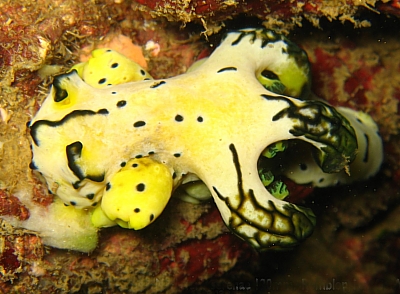
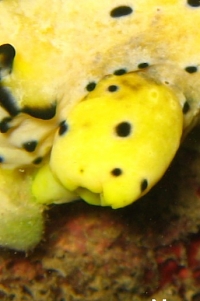
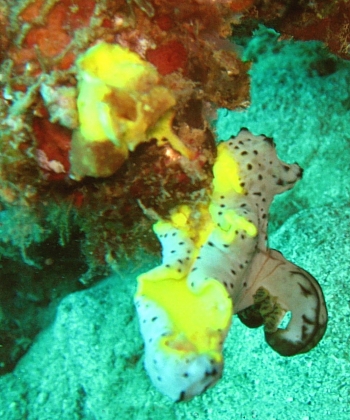
Dear Gaetan,
I am sure there is much environmental destruction occurring in the places you have visited, but unless you have regular observations over a long period, it's difficult to know whether what you saw in Sibuyan Island is permanent environmental damage or part of a seasonal cycle. In tropical waters a rapid influx of freshwater from flooded rivers can dramatically change local ecosytems in a few days, but if it is part of a seasonal cycle things seem recover quite quickly. Your example may be an environmental catastrophe but I guess only time will tell.
There seems to be some bits of the yellow sponge they feed on in all your photos [I have added a close-up in the top photo]. Its apparent absence may be because the nudibranchs have just about eaten all the colonies. Concerning the yellow 'gunge'. Notodoris serenae has a bright yellow foot so much of the colour in your lower photo is the bright yellow sole of the foot. The yellow mucus-looking secretion on the sponge and the foot is probably a defensive secretion produced by the animal. I am puzzled by the 'pouches' in the middle photo. Perhaps the large animal has crawled over a smaller one already feeding on the sponge beneath them? I am afraid I can only guess. I guess its important to a to do a bit of gentle 'poking and prodding' when you see something peculiar. If you didn't notice it unitl you looked at your photos then it has to remain one of 'life's little mysteries'.
The 'bordeaux-red stuff ' certainly looks like a sponge, but I am pretty sure it is not a calcareous sponge, which are what species of Notodoris feed on.
Best wishes,
Bill Rudman
Notodoris serenae from Sabah, Malaysia
June 19, 2007
From: Richard Swann
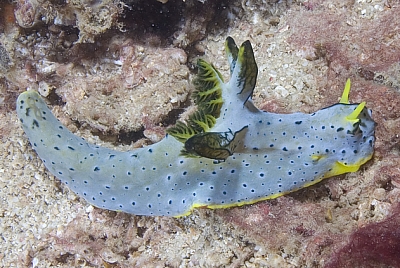
Concerning message #15654:
Hi Bill
I was out with my 12-24 wide angle lens today not expecting to be able indulge in my favourite subject "Nudi's" when i stumbled across this Notodoris serenae.
Locality: west Sulug Island, 21 meters, Sabah, Borneo, South China Sea, 01 June 2007, Reef slope, outreef. Length: Approx 125mm. Photographer: Richard Swann
I have never seen one in my area before so it was a wonderful treat, due to it's large size was able to capture a record for the forum and add to your distribution information ! Sorry it's not a feeding shot but i did my best with the tools to hand !
Thanks and best regards
Richard
www.downbelow.co.uk
richard@downbelow.co.uk
Swann, R., 2007 (Jun 19) Notodoris serenae from Sabah, Malaysia. [Message in] Sea Slug Forum. Australian Museum, Sydney. Available from http://www.seaslugforum.net/find/19974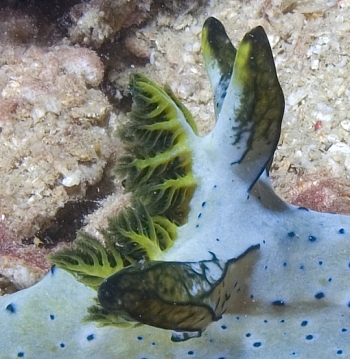
Thanks Richard,
Best wishes,
Bill Rudman
Notodoris serenae from Malaysia
February 10, 2006
From: Kerem Turker
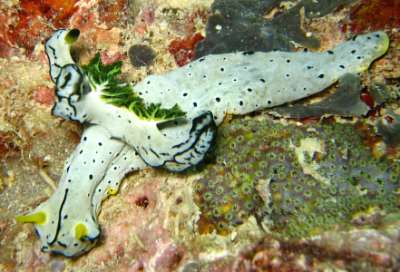
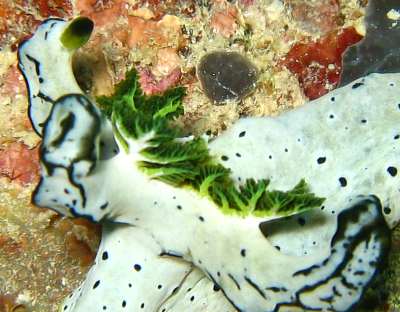
Hi Bill,
First of all, you are doing a great job on your site both for the sake of nudi lovers and for the information sharing. I have recently discovered your side and happy to check every day to get new info.
Attached you can find two pictures of a nudi, I have photographed in Malaysia, that I am really curious about, as I have not seen anything like this before.
Locality: Mabul Island, Malaysia, Celebes Sea. Depth: 15 meters. Length: ~10 cm. 02 November 2005. muddy (beneath the oil platform). Photographer: Kerem Turker
If you could provide more info about this one I would be glad.
Regards,
Kerem Turker
kerem.turker@pmintl.com
Turker, K., 2006 (Feb 10) Notodoris serenae from Malaysia. [Message in] Sea Slug Forum. Australian Museum, Sydney. Available from http://www.seaslugforum.net/find/15654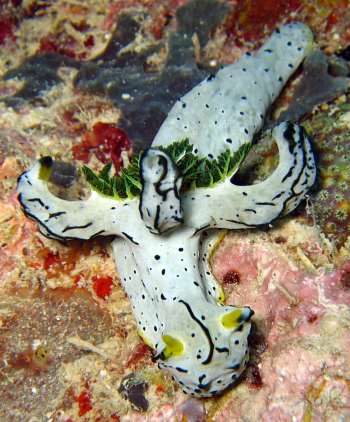
Dear Kerem,
This is Notodoris serenae, a large spectacular nudibranch known at present only from the western Pacific.
I should mention that Fahey & Gosliner (2004) came to the conclusion, after the diligent use of cladistic analysis, that Notodoris should be considered part of the genus Aegires, so you will see this species named Aegires serenae by some authors. I am uncomfortable in immediately accepting the results of cladistic analyses, without reflection, or before further studies of this group are undertaken. Part of the scientific method is to test hypotheses. If we just accept things as soon as they are proposed, we miss out a vital step in the scientific method. Fortunately immediate acceptance of cladistic analyses is not yet compulsory, so I prefer to retain Notodoris until further studies of this group are undertaken.
-
Fahey, S. J. & Gosliner, T. M. (2004) A Phylogenetic Analysis of the Aegiridae Fischer, 1883 (Mollusca, Nudibranchia, Phanerobranchia) with Descriptions of Eight New Species and a Reassessment of Phanerobranch Relationships. Proceedings of the California Academy of Sciences, 55, (34): 613–689, 82 figs., 4 tables (Appendix).
Best wishes,
Bill Rudman
Re: Notodoris serenae from Indonesia
December 24, 2004
From: Douglas Hansen
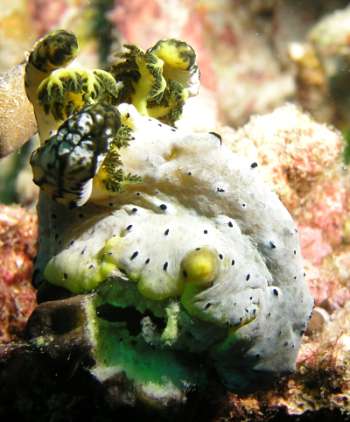
Dear Bill,
We found this dorid in about 10 to 15 meters in a sand and rubble bottom off of Menjangen Island in northern Bali [Indonesia]. This nudibranch was quite large, nearly 10 cm. We have not been able to identify it in any of our books, and were wondering if anyone had an idea of what it might be?
Best wishes
Douglas Hansen
mhel0323@sbcglobal.net
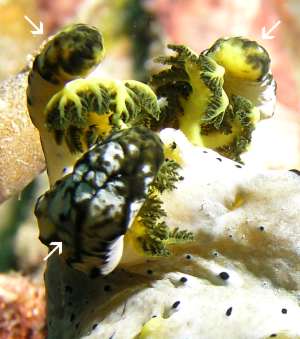
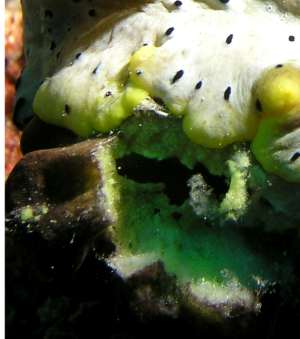
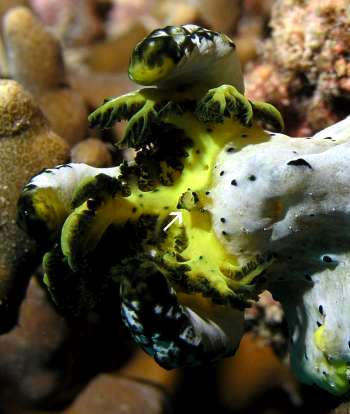
Dear Douglas,
This is Notodoris serenae. I've added a few close-ups of parts of your photos as they show some quite interesting features of this quite rarely seen species. In the one above of the gills, I have added arrows to show the three fleshy lobes this species has to enclose, and apparently protect, the gills from nibbling fish. Alongside that photo I have included a close-up showing the half-eaten sponge colony it is feeding on. I guess it is the calcareous sponge Leucetta chagosensis Dendy, 1913 on which it is reported to feed. The photo alongside shows the gills from directly above and you can see the anal papillae (see arrow). In dorid nudibranchs, the gills are usually arranged in an arc or a circle around the anus. This might seems strange, but in their evolutionary past, when they still had shells, the gills and the anus were close together in the mantle cavity just inside the mouth of the shell, and they have remained associated over millions of years.
Best wishes
Bill Rudman
Notodoris serenae from Solomon Ids
October 24, 2003
From: Bruce Potter
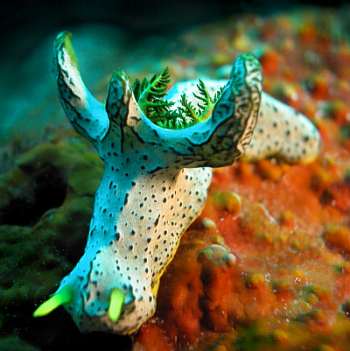
Dear Bill,
I found this Notodoris serenae last weekend [October 2003]on a dive site called Freight Express in the Florida group of the Solomon Islands. It was at about 21 meters down a shere wall.
What I really noticed was the brilliant yellow colour of the foot. It was the same as the rhinophores.
The creature was about 45mm long.
Regards
Bruce Potter
bruce.potter@adventist.org.sb
Potter, B., 2003 (Oct 24) Notodoris serenae from Solomon Ids. [Message in] Sea Slug Forum. Australian Museum, Sydney. Available from http://www.seaslugforum.net/find/11301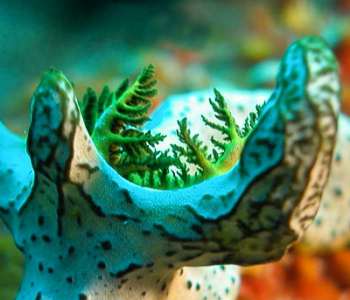
Thanks Bruce,
The bright yellow seems to occur also in the gills and rhinophores
Bbest wishes
Bill Rudman
Notodoris serenae from Okinawa
June 28, 2003
From: Kaoru Imagawa
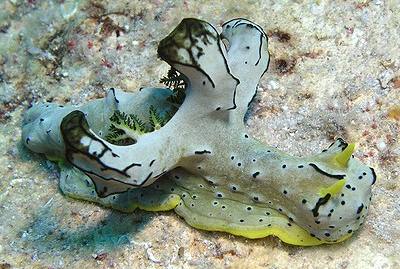
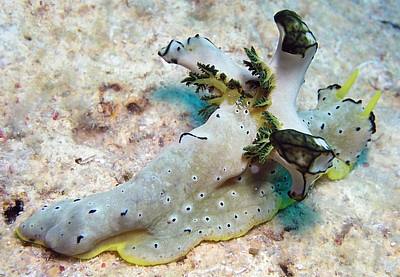
Dear Bill,
I found this Notodoris serenae about two month ago. It was found in a rocky area. I think it is very rare to see it in Japan. Don't you agree?.
Date: 29 April,2003
Location: Seragaki Beach, Okinawa Japan
Depth: 22 m
Length: 90 mm
W/Temp: 24 C degree
Photo by Kaoru Imagawa
Best Regards,
Kaoru Imagawa
diver@mvi.biglobe.ne.jp
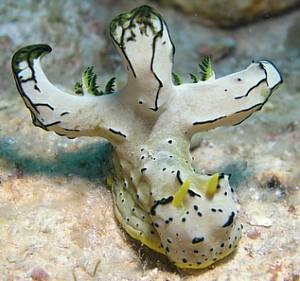
Dear Kaoru,
Thanks for these excellent photos. As far as I know Notodoris serenae hasn't been recorded from the main islands of Japan and is considered a rare find in Okinawa.
Best wishes
Bill Rudman
Notodoris serenae from the Solomon Ids
September 20, 2002
From: Bruce Potter
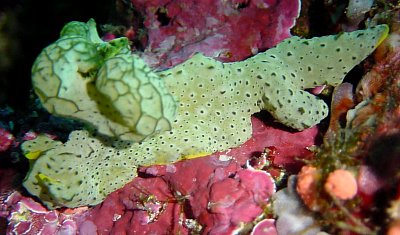
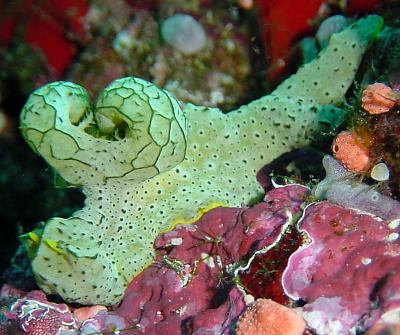
Dear Bill,
I have just returned from a trip to the Russell Islands in the Solomon Islands. On a dive site called Kaukau, I found this Notodoris serenae. This is not a common find here. I have sent it because of the adbnormality visible towards its tail.
This would have been about 60mm long, and was on a vertical wall at about 15metres.
Regards,
Bruce Potter.
bruce.potter@adventist.org.sb
Potter, B., 2002 (Sep 20) Notodoris serenae from the Solomon Ids. [Message in] Sea Slug Forum. Australian Museum, Sydney. Available from http://www.seaslugforum.net/find/7933Thanks Bruce,
Bill Rudman.
Notodoris serenae from Moyo Island, Indonesia
August 10, 2002
From: Walabha Sinbul
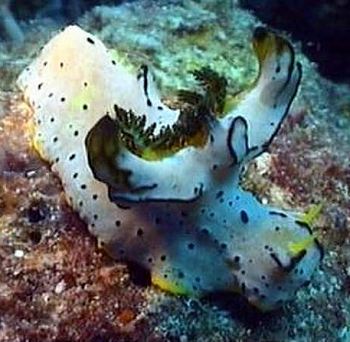
Dear Bill,
Please help me with the ID. I have no idea who this guy can be. He looks like a moose, I'd say.
Dive site: Moyo Island, Indonesia
Depth: 30ft.
Size: 5cm.
Activity: feeding on green algae
Thanks so much.
Walabha
walabha@clickta.com
Sinbul, W., 2002 (Aug 10) Notodoris serenae from Moyo Island, Indonesia. [Message in] Sea Slug Forum. Australian Museum, Sydney. Available from http://www.seaslugforum.net/find/7712Dear Walabha,
Certainly from the interesting angle you have photographed it, it does look like a moose! This is Notodoris serenae. You mention it was feeding on green algae. It may have been crawling over some green algae, or perhaps its sponge was a bit green in colour, but these animals feed on the calcareous sponge Leucetta [see Stuart Hutchison's message]. It is often easy to be tricked when watching animal behaviour - and it is often quite difficult to know just what an animal is actually feeding on. Even when you actually see an animal feeding it is often difficult to identify what the food is, and other times when you think an animal is feeding, it is just crawling over something
Best wishes,
Bill Rudman
Notodoris serenae from Papua New Guinea
October 8, 2001
From: Marli Wakeling
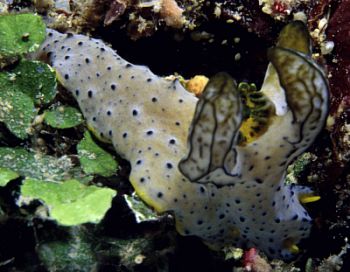
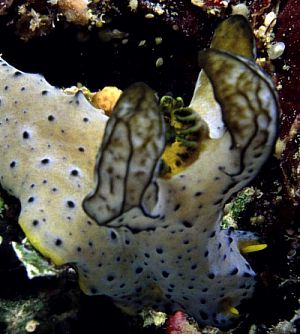
Dear Bill,
Here is a Notodoris serenae from Papua New Guinea. Location: Nusa Blowholes, Kavieng, Papua New Guinea
Depth: 10 metres
Length: 6 cm
Photograph: Marli Wakeling
Best wishes,
Marli
scubamarli@excite.com
Wakeling, M., 2001 (Oct 8) Notodoris serenae from Papua New Guinea. [Message in] Sea Slug Forum. Australian Museum, Sydney. Available from http://www.seaslugforum.net/find/5369Thanks Marli,
I have never seen this species alive so it is good to get a variety of photos of it. This animal seems to show quite a lot more yellow than in other photos I have seen and clearly shows a yellow and black band around the edge of the foot.
Cheers,
Bill Rudman
Notodoris serenae from Tufi, Papua New Guinea
October 2, 2001
From: Des Paroz
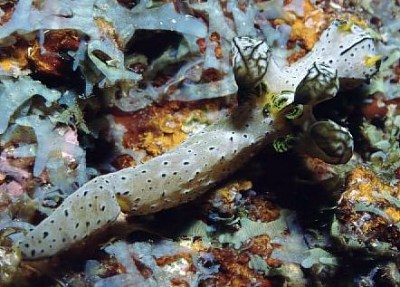
Dear Bill
Attached are 2 photos of what I believe to be Notodoris serenae, taken at Stewarts Reef, offshore of Tufi in Oro Province, Papua New Guinea. Depth was about 24m, and the water temp was around 28C. The third photo shows an egg mass that was spotted first. The nudi was then found only a few centimetres from the mass.
Note that the nudi also seems to have an injury or deformity in the "tail section". I have to say that this is one of the most elegant looking slugs I've yet seen.
Best regards
Des
des@paroz.com
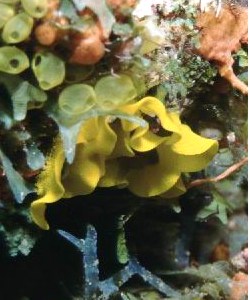
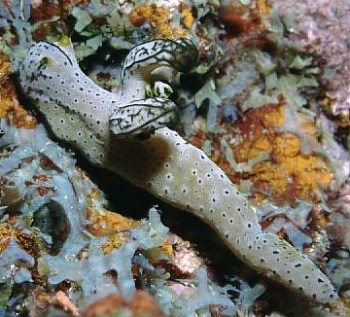
Thanks Des,
Your photos show very clearly how the three protective tubercles which protect the gills in the yellow species of Notodoris, such as N. minor, have become almost decorative in this species. Concerning the egg mass. As a general rule it pays to be suspicious about egg masses of unknown parentage. A nudibranch close by could mean that it has recently laid it, but it could also mean it was just crawling past. Certainly the colour and the shape are similar to the egg masses of other species of the genus.
And yes, the 'tail section' does seem to have suffered some recent damage.
best wishes,
Bill Rudman
Notodoris serenae from Papua New Guinea
June 5, 2001
From: Stuart Hutchison
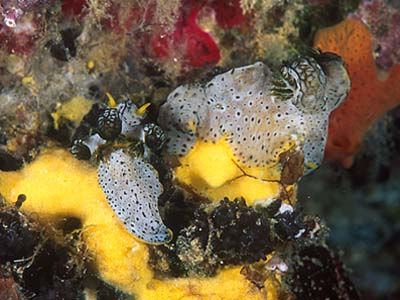
Bill,
Here's two Notodoris sp. from Milne Bay, Papua New Guinea. 2 Apr 1998, 21m, shorter animal was about 50mm long.
Regards,
Stuart
hutchco@tpg.com.au
Hutchison, S., 2001 (Jun 5) Notodoris serenae from Papua New Guinea. [Message in] Sea Slug Forum. Australian Museum, Sydney. Available from http://www.seaslugforum.net/find/4492Thanks Stuart,
This is Notodoris serenae. The only thing yellow in this species are the rhinophores. I guess the yellow sponge both animals are on is their food - a calcareous sponge of the genus Leucetta.
Best wishes,
Bill Rudman
Notodoris serenae from Solomon Ids
October 27, 2000
From: Bruce Potter

Bill,
I filmed this Notodoris out in the Russell Islands, in the Solomons. It was about 12 meters down a vertical wall in a small cave.
I identified it as Notodoris sp., but recently saw the same creature in a book by Bob Halstead, in which he identified it as Notodoris serenae. I couldn't find it in your creature list, and so am passing it on to you.
Bruce Potter
bruce.potter@adventist.org.sb
Potter, B., 2000 (Oct 27) Notodoris serenae from Solomon Ids. [Message in] Sea Slug Forum. Australian Museum, Sydney. Available from http://www.seaslugforum.net/find/3233Thanks Bruce,
Yes it is a gap in my list which I am very happy to have filled.
Best wishes,
Bill Rudman
